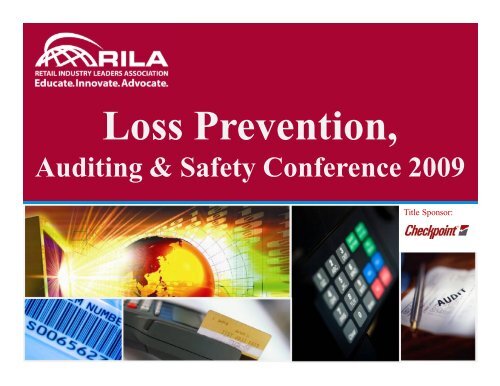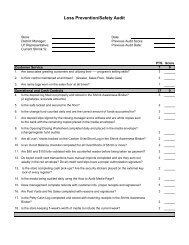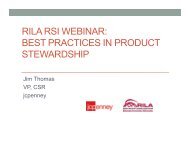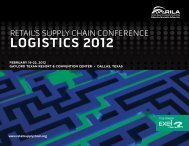Evans, Beck
Evans, Beck
Evans, Beck
You also want an ePaper? Increase the reach of your titles
YUMPU automatically turns print PDFs into web optimized ePapers that Google loves.
Loss Prevention,<br />
Auditing & Safety Conference 2009<br />
Title Sponsor:
Collaborative Approaches<br />
to Successful Shrinkage<br />
Management<br />
Shawn <strong>Evans</strong>, Shrink & On-Shelf Availability Leader , Procter & Gamble Co.<br />
Adrian <strong>Beck</strong>, Reader in Criminology, University of Leicester, UK
Session Content<br />
• Getting to Grips with Shrinkage<br />
• Understanding the Root Causes<br />
• Identifying Root Causes<br />
• Keys Steps to Collaboration<br />
• Case Studies in Collaboration
Getting to Grips With Shrinkage<br />
• Slippery Term<br />
• What is the Scale of the Problem<br />
• Understanding the Causes
Defining Shrinkage<br />
Shrinkage<br />
intended sales income that was not and cannot be realised<br />
Malicious<br />
Non Malicious<br />
External<br />
Theft<br />
Internal<br />
Theft<br />
Inter-comp<br />
Fraud<br />
Spoilage<br />
Pricing<br />
Errors<br />
Damage<br />
Delivery<br />
Errors<br />
Data<br />
Errors<br />
Scanning<br />
Errors
Cost of Shrinkage<br />
Year<br />
Source Size (%)<br />
2003 National Supermarket Research Group (US) 2.32<br />
2005 ABRAS Supermarket Shrinkage Survey (Brazil) 2.05<br />
2004 ECR Europe Shrinkage Survey (18 European countries) 1.84<br />
2003 Retail Council of Canada 1.75<br />
2007 Food Marketing Institute (US) 1.52<br />
2002 ECR Australia 1.52<br />
2003 New Zealand Survey of Retail Theft and Security 1.50<br />
2008 National Retail Security Survey (US) 1.44<br />
2008 Global Retail Theft Barometer (36 countries) 1.34<br />
2003 Eurohandelinstituts (Germany) 1.23<br />
Average 1.65
Cost of Shrinkage<br />
• Annual global losses<br />
• $232 billion<br />
• Cost of managing shrinkage<br />
• $46.4 billion<br />
• Ignores consequential losses<br />
• Additional transport, out of stocks, defensive<br />
merchandising etc
What does $278 billion buy?<br />
New Zealand<br />
Kuwait<br />
Luxembourg<br />
Iceland
Perceived Causes of Shrink<br />
Study<br />
Non<br />
Malicious<br />
Malicious<br />
Process<br />
Inter-company<br />
fraud<br />
Internal<br />
External<br />
National Retail Security Survey (US) 15 4 44 34<br />
Global Retail Theft Barometer 16 6 36 41<br />
Food Marketing Institute (US) 21 9 39 32<br />
ABRAS Supermarket Shrinkage Survey (Brazil) 65 8 16 12<br />
ECR Europe Shrinkage Survey 27 7 28 38<br />
Retail Council of Canada 18 7 40 35<br />
New Zealand Survey of Retail Theft & Security 20 3 12 68<br />
National Supermarket Research Group (US) 57 20<br />
ECR Australia 29 11 25 35<br />
Average 26 8 33 35
True Cause of Shrinkage<br />
Shrinkage<br />
intended sales income that was not and cannot be realised<br />
Malicious<br />
Non Malicious<br />
External<br />
Theft<br />
Internal<br />
Theft<br />
Inter-comp<br />
Fraud<br />
Spoilage<br />
Pricing<br />
Errors<br />
Damage<br />
Delivery<br />
Errors<br />
Data<br />
Errors<br />
Scanning<br />
Errors<br />
Operational Failures
Operational Failures<br />
• any fault in the design, implementation, operation,<br />
monitoring and control, and review of processes and<br />
procedures used within the retail environment.<br />
• Can be identified by root cause analysis<br />
• Any point in the supply chain
Examples of Operational Failures<br />
• The Lost Key<br />
• Problem: Stock is left outside the secure cage<br />
• Why? Because the key holder is on holiday and did not give the key to another member of staff<br />
• Why? Because they assumed there was another key<br />
• Why? Because this is what existing store procedures stated, but unfortunately this was not now being followed<br />
• Why? Because the store manager had not reviewed operating procedures for over 12 months<br />
• Why? Because the store manager was under considerable pressure to focus on sales<br />
• The Speedy Forklift<br />
• Problem: High levels of damaged stock in DC<br />
• Why? Because forklift truck drivers are regularly crashing into pallets of stock<br />
• Why? Because they are driving too fast<br />
• Why? Because their pay is determined by the number of pallets moved in a day<br />
• Why? Because this was seen as a good way to improve productivity
Examples of Operational Failures<br />
• Less Till Checking<br />
• Problem: Cash theft has risen at the till<br />
• Why? Because more staff are stealing from the till<br />
• Why? Because they think it is easy to get away with it<br />
• Why? Because the till is no longer checked after each shift only at the end of the day<br />
• Why? Because store operations reduced the number of till supervisors working in the store<br />
• Why? Because it enabled them to save money on salaries<br />
• Poor Packaging<br />
• Problem: A product is always out of stock on the shelf<br />
• Why? Because it is in the store room<br />
• Why? Because replenishment team cannot find it<br />
• Why? Because all packs seem to look the same<br />
• Why? Because there is no differentiation except by barcode<br />
• Why? Because the Packs were designed to suit DC operation
Opportunity and Operational Failure<br />
• Opportunity makes the thief<br />
• Situations and opportunities<br />
• Risk, effort and reward<br />
• Understand root causes rather than symptoms
Identifying Operational Failures<br />
• The Shrinkage Road Map<br />
Root cause analysis<br />
Failure, Mode and Effect Analysis<br />
Process mapping<br />
5 Whys<br />
Detailed data analysis
Shrinkage Road Map Principles<br />
• Be systemic<br />
• Be systematic<br />
• Focus on the vital few: The hot concept<br />
• Get accurate and timely data<br />
• Adopt a collaborative approach….
P&G – why do we care about shrink<br />
• Shopper is boss: Shrink impacts the shopper<br />
• We can bring solutions<br />
• Insights – Shopper & Thieves<br />
• At source solutions<br />
• Expertise and best practice<br />
• Get it right: $$$$ profit opportunity for P&G and<br />
our customers
200+ Collaboration Projects Completed
The “Remove Opportunity” Approach<br />
Shrinkage<br />
Process<br />
failures<br />
Intercompany<br />
fraud<br />
Internal<br />
theft<br />
External<br />
theft<br />
Conventional approach<br />
ECR approach
Collaboration Process
Retailer Case Study – Collaboration Team<br />
Retailer<br />
• Buying<br />
• Store Operations<br />
• Loss Prevention<br />
• D.C. Operations<br />
• Systems (I.T.)<br />
• Process Solution Manager<br />
Procter & Gamble<br />
• Sales Executive<br />
• Category Management<br />
• Store Operations Manager<br />
• Customer Logistics Manager<br />
• Shrink & On-Shelf Availability<br />
Leader
Collaboration Project Goals<br />
• Sell More Lose Less<br />
• Increase sales<br />
• Reduce shrink<br />
• Improve instocks<br />
• Optimize store labor / efficiency<br />
• Understand process “Realities” D.C. / Stores<br />
• Develop collaborative holistic shrink reduction solutions
Sell More Lose Less Collaboration Agenda<br />
Two and a half day Road Map Session<br />
• D.C. Tour – followed Fusion receiving through shipping<br />
• Store visits – high / low shrink store comparison<br />
• Process map end to end process steps<br />
• Identify process failures<br />
• Root cause analysis<br />
• Develop solutions<br />
• Create solutions / market test action plan<br />
• Present findings to sr. management steering team
Analyzing The Process
Sell More Lose Less Identified Solutions<br />
Process & Procedures<br />
• Secured Supply Chain<br />
• Regular Counting “Hot Products”<br />
• Store Receiving - Inventory Counting<br />
Equipment & Systems<br />
• Store Item Level Hot Product Report<br />
• Secure Storage Rooms / Zip Tied<br />
Totes<br />
People<br />
• Store Shrink Champion<br />
• Training & Awareness Program<br />
• Hot Store & Product Focus<br />
• Aggressive Hospitality<br />
Product<br />
• Product Protections – Keeper Cases<br />
/ EAS Tagging<br />
• Assortment / Stocking<br />
• Layout & Section Design
Collaboration Project Test Results<br />
• Sales increase 1% (Self Selection Fixture vs. Keepers)<br />
vs. control store<br />
• Shrink reduced 100% vs. control stores<br />
• Instocks improved 49% vs. control stores<br />
• Consumer focus group results provided positive<br />
shopper experience feedback
P&G Shrink Collaboration Approach<br />
• Stop blaming: • the shopper • each other • ORC /Winona Ryder<br />
• Collaborate and engage all stakeholders:<br />
• Create an ‘end-to-end’ solution across buying; logistics;<br />
store ops; loss prevention; manufacturers<br />
• Engage, not just tell<br />
• Focus effort on:<br />
• Hot products<br />
• Hot Stores<br />
• Work the processes:<br />
• Products; Information; Money<br />
• Identify and remove opportunity for loss and error<br />
• Evaluate & learn
THANK YOU!<br />
QUESTIONS?<br />
<strong>Evans</strong>.sr.1@PG.com<br />
bna@le.ac.uk





